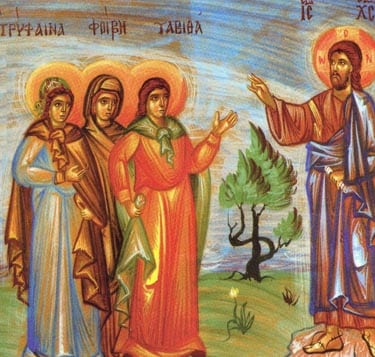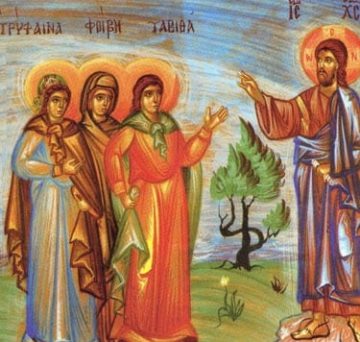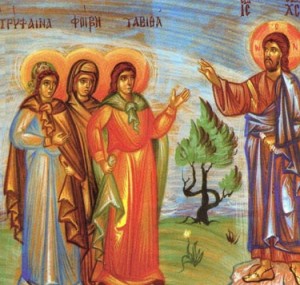Oh, this is a fun message! The text is reverent; it is focused on the work and service of Christ, inviting Visiting Teachers to serve as Christ did. It includes a suggested list of items that might assist you to become better acquainted with the women you are assigned to serve, including the important direction to “love them without judging them”.
The fun part is in theoretical and real application of the scripture and history sections. The 3 Nephi 11 scripture and the Romans 16 history references are interesting because of the time frame wherein these scriptures were authored. 3 Nephi 11 is noted as occurring in “about A.D. 34” (Christ’s visit to the Nephites/Lamanites), and Romans 16 was from the ministry of Paul, which was about 50 C.E. (A.D.). (1) As both of these reference the time of Christ and the time just following Christ’s resurrection, I believe that an intentional statement is being made in regard to the traditional devout responsibilities of women within the church, including the potential for women to be ordained to the priesthood.
So let’s look at the message:
From Our History
“The New Testament includes accounts of women, named and unnamed, who exercised faith in Jesus Christ. … These women became exemplary disciples. … [They] journeyed with Jesus and His Twelve Apostles. They gave of their substance to assist in His ministry. After His death and Resurrection, [they] continued to be faithful disciples.”(Daughters in My Kingdom, 3.)
Paul wrote of a woman named Phebe, who was “a servant of the church” (Romans 16:1). He asked the people to “assist her in whatsoever business she hath need of you: for she hath been a succourer of many” (Romans 16:2). “The kind of service rendered by Phebe and other great women of the New Testament continues today with members of the Relief Society—leaders, visiting teachers, mothers, and others—who act as succorers, or helpers, of many.” (Daughters in My Kingdom, 6.)
Who exactly was Phebe?(2) The scriptural female famine results in one taking special note when a woman is mentioned in scriptures. Especially if she is a deaconess, such as the bible describes Phebe as being. As this is the case, what is the “deaconess” service that she rendered and with which the month’s message is telling us to emulate? Valerie Abrahamsen addresses Phebe and her position quite well:
The first woman deacon that we know of is Phoebe, from Romans 16:1, and she is a designated diakonon. A great deal of ink has been spilled in the standard references describing “deaconesses.” However, it should be noted that the specific term diakonissa (Latin and Greek spellings) did not come into use until the fourth century, whereas diakonos was used in various sense as early as Clement (about 213.C.E.) and Basil (379 C.E.). Among its several meanings, diakonos can be translated as “minister”: whether male or female, a deacon was a minister. The usual double standard employed by dividing functions by gender is not only misleading but often incorrect.
The roles and functions of the earliest deacons were varied. In the Didache, bishops and deacons are mentioned together and are expected to be gentle (preis), generous (aphilargyrous), faithful (aletheis) and well tried (dedokimasmenous). Their ministry “is identical with that of prophets and teachers (Cyril C. Richardson, ed. Early Christian Fathers, New York, Macmillan Publishing, 1978, p.178).”
What emerges, then, is a fairly complex picture of ecclesiastical roles and functions of the early churches which were not necessarily gender specific.(3)
So- what does this mean for visiting teachers? We are often admonished to minister, wherein the term minister is used as a verb. But it is clear that the term is also a noun. Like Phebe, we are ministers (noun), inasmuch as we minister (verb) to each other. In completion of visiting teaching, we fulfil an ecclesiastical role that was assigned to women (and men) in the period during and after Christ walked the earth. When I consider myself as a minister –as a purpose-driven representative of Christ– with the responsibility of fulfilling His work under His guidance, the act of ministering becomes a personal passion, rather than a stock assignment. Hence, we are directed in this month’s message to become personally acquainted with the women we visit teach, just as Christ would if he were a visiting teacher. We are to become ministers/deaconesses, so we can attend to each other as Christ would, were He here in the flesh.
Although the modern LDS church does not currently set apart women with active priesthood keys, it was Joseph Smith who said that the Relief Society was based on an antediluvian female order. As quoted by Eliza R. Snow, “Although the name may be of modern date, the institution is of ancient origin. We were told by our martyred prophet that the same organization existed in the church anciently.” (5) If we consider that the scriptures referencing Phebe are canonized, and that Joseph Smith’s revelation that Relief Society is based on an ancient organization, then we must ask: Is this message suggesting that visiting teaching is the core duty of priesthood-bearing women? Consider this:
The evidence of ordained female deacons in the early Christian period, at least in portions of the Easter Church, is clear and unambiguous. That deaconesses continued to exist from the early through the middle Byzantine period, at least in Constantinople and Jerusalem, is also indisputable. While the literary record does not give a detailed and comprehensive picture of the female diaconate, especially with respect to liturgical activities, the order appears to have thrived in the early Byzantine period.(4)
Is this message suggesting the we prepare for women’s priesthood ordination in the modern church, in parallel to becoming aligned with the same responsibilities of women in the ancient church? More to the point, should Latter-day Saint women be ordained with priesthood keys just as women in the ancient church?
I told you this was a fun message.
Because I think women are awesome. Even if we don’t have active priesthood keys, are refused priesthood keys or are uncomfortable with the concept of female ordination. We, as women, are awesome enough to do the work of Christ no matter our standing in the church. And this message and associated scripture agree: women have the assignment to act in a manner of and be ministers. More importantly, I think there is potential for us to become more closely aligned to the church that Christ originally designed when we recognise and emulate the women of the “ancient” church through visiting teaching. Because all women have the capability and design to be brilliant and powerful servants of Christ…. even if active ordination is currently withheld from us in this pre-millennial period. I think that visiting teaching just happens to be a great vehicle for this practice of service to and emulation of Christ. In this we, like Phoebe, who was ordained and armed with the Holy Ghost, have the direction and authority to do Christ’s work on earth.
3 Nephi 11: 35 Verily, verily, I say unto you, that this is my doctrine, and I bear record of it from the Father; and whoso believeth in me believeth in the Father also; and unto him will the Father bear record of me, for he will visit him with fire and with the Holy Ghost.
Moroni 6:4; And after they had been received unto baptism, and were wrought upon and cleansed by the power of the Holy Ghost, they were numbered among the people of the church of Christ; and their names were taken, that they might be remembered and nourished by the good word of God, to keep them in the right way, to keep them continually watchful unto prayer, relying alone upon the merits of Christ, who was the author and the finisher of their faith.
This message, with analysis, delights in the development and ministering of women of Christ. In properly performing visiting teaching, we are paralleling some of the same duties that were attributed to ordained women when Christ and His disciples walked the earth. Like Phebe, we become ministering disciples of Christ. As the message begins:
Throughout His mortal life, Jesus Christ showed His love for others by ministering to them. He said, “By this shall all men know that ye are my disciples, if ye have love one to another” (John 13:35). He set the example and wants us to “succor those that stand in need of [our] succor” (Mosiah 4:16). He calls His disciples to work with, Him in His ministry, giving them the opportunity to serve others and become more like Him. (Daughters in My Kingdom, 105)
In closing….“Paul the Apostle anciently spoke of holy women. It is the duty of each one of us to be a holy woman. We shall have elevated aims, if we are holy women. We shall feel that we are called to perform important duties. No one is exempt from them. There is no sister so isolated, and her sphere so narrow but what she can do a great deal towards establishing the Kingdom of God upon the earth.”- Eliza R. Snow
So get to know the women you visit teach. Get to know them well, so that they know and trust you as a servant of Christ.
How do you think you can best serve through visiting teaching as a disciple of Christ?
How do you feel about Phebe and the potential to be ordained as a Deaconess?
1. B.C. and A.D. are somewhat antiquated reference terms; in modern academia, the references are B.C. E. (Before The Common Era), equal to B.C., and C.E. (Common Era), equal to A.D. The texts I used for reference use both reference styles, so I note this for the reader’s clarity.
2. Phebe, Phoebe and Pheobe are all variant spellings of the same name. The name is Greek in origin, and translates to “bright” and “shining”.
3. Journal of Feminist Studies in Religion, Valerie Abrahamsen, “Women at Philippi: The Pagan and Christian Evidence”, Vol. 3., No. 2 (Fall 1987), p 17-30.
4. Church History, Cambridge University Press, Valerie A. Karras, “Female Deacons on the Byzantine Church”, Vol. 73, No. 2 (June 2004), p 272-316.
5. Daughters in My Kingdom, Chapter One heading.







8 Responses
Oh, lovely!
A dear friend of mine, a Nazarene pastor, explained her beliefs to me once by saying that Nazarenes are called to be Christlike — and in such a way that they act as Jesus Christ for the people around them. I adore this idea. Frequently our lessons on being Christlike are focused on attributes rather than actions, and I find myself more drawn to the phrase “What Would Jesus Do?” than to our ubiquitous “Choose the Right.” But the Nazarene idea seems to be fully integrated: Who would Jesus be for someone he loved? A listener? A motivator? A hugger? A friend who brought banana bread? I have to believe that the one who knows all our sorrows also knows how to comfort us in the way we need it most. For me, that seems to be what visiting teaching is about: learning someone else’s needs and growing (sometimes painfully) to be someone who can meet them. It is holy, and it is God’s work, and isn’t priesthood defined as the power given to people to do God’s work on earth?
Thank you, Libby! I love your thoughts, i.e. “Who would Jesus be for someone he loved?” I am going to keep that in mind with my communication in visiting teaching- you worded it simply and perfectly. <3
I really appreciate the hard work and the research that you put in this piece. But, I did some reading on my own and I have a few questions for you.
)diakonissa, which you say can be either male or female, yet, when I looked it up on a religion web site in reference to the Apostle Paul it stated that grammatically speaking it usually refers to the male being and was speaking towards Paul’s authority in the church.
2) I am also troubled by Paul’s often contradictory statements about women in the church. In a letter he wrote to Timothy, Paul stated,” A woman should learn in quietness and full submission . I do not permit a woman to teach or assume authority over a man . She must be quiet.
And yet again, another contradictory message about women by the Apostle Paul ,” There is no longer slave or free for all are one in Christ Jesus.
I would appreciate clarification because there seems to be a certain of duplicity going on. Its like he can’t decide whether or not he wants to be egalitarian or he wants us to shut our mouths.
This wasn’t meant to be read as a rant, I didn’t know how to make a coherent paragraph so I decided to make it into a list, it just seemed simpler that way.
Excellent queries, Diane.
I am not sure of your referencing for diakonissa. As mentioned, the term did not come into use until the fourth century. I would suggest that you clarify the time period for which the source is noting to verify the period of interpretation, as well as verify its origin- i.e. greek or latin. The reference for the term in this work is Oxford, s.v. “deaconess”, and TDNT, s.v. “diakonos”.
I think Bernie Dianzon makes some good points in regard to the contradictory statements recorded by Paul and the Paulines that is more supportive of feminist ideology than other interpretations. But the important thing is, what do you think of these contradictions? What rings true to you, assuming that the bible in these sections is specifically interpreted correctly?
So, I’ve done some more reading, and research and around 67AD diakonos was also translated as a(lit Servant) Prostatis (Greek) when used in conjunction with Diakonis means women in a supportive role. So, I guess Paul saw Women serving other women in that function as being okay and worthy. Women serving men in supportive roles (the research I read showed that Pheobe probably financed Paul’s mission.
It still leaves one with questions as to whether or not he really saw women as being equal to men. In the letters to Paul,(at least according to some of the reading I’ve done, and which my interpretation may or may not be accurate) he said that his feelings on the matter of women in the church as a matter of practice, rather than advice.( Not really sure what that means or how that should be interpreted)
Sorry, it should have read in letters written to Timothy(not letters written to PauL)
Interesting ideas. I think you might enjoy reading the academic articles referenced in this post and see if they can marry up to your thoughts on Paul. What is your source for the 67 A.D. / C.E. definition? I would be slightly wary of A.D.-defined sources as potentially biased. But- the important thing is, what do you think? If Phebe financed Paul’s mission, do you think this visiting teaching message is limiting only women of financial substance as those allowed to have priesthood or be called as servants of Christ? What are your thoughts on this as a visiting teaching tool to empower women?
Spunky
I’ve been doing more reading, and the reading brings more questions because every scholarly paper I’ve read seems to both correlate, and contradict what I’ve read in previous papers as well as what you’ve posted.
For instance, in one paper, they referenced the culture of the times, which on the face of it, seems perfectly legitimate thing to do. The author stated that during the time period, it was customary to meet in the members houses where there was no particular order in things, and everyone was speaking out of turn. The author of the article believed that when Paul wrote the paper he was trying to give order to a chaotic situation, not necessarily saying that women shouldn’t speak. Another author stated that he believed that Paul only believed that only married women shouldn’t speak out of turn. They should let their husbands talk for them.
And yet, another believed that everything hinges on how you interpret the word “head” which some interpret as meaning “source” and others”authority”
What I really find interesting is that ALL of these sources lay the blame for this contradiction with Paul at the hand of Eve, specifically because she lied and led Adam down a path of deception.”Women still get all the blame.”
And there are others who believe that the interpretation lays on whether or not you believe Paul to be more interested in gender based authority vrs. covenant based authority.